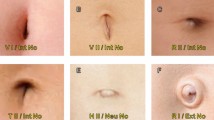Abstract
Background
Single-incision laparoscopy (SIL) is a rapidly growing procedure in the field of surgery. The most frequent site of abdominal access is the umbilicus. Its appearance can be altered during SIL procedures. The literature suggests that the umbilicus plays an important role in the overall physical appearance of patients. This study therefore investigated the perception of the general population regarding the cosmetics of the umbilicus.
Methods
An online survey with 10 questions about the aesthetic importance of the umbilicus was circulated worldwide in both the English and French languages. All the answers then were gathered and analyzed.
Results
The majority of the participants considered both their umbilicus and that of their partner as “unimportant.” The total loss of their umbilicus and any undesired changes in its size, shape, and skin color were considered disturbing by most participants, but not its depth. In this survey, 39% of the women and 29% of the men agreed on a negative impact of an undesired change in their umbilicus, whereas 19% of the women and 36% of the men agreed on a negative impact of such a change in the umbilicus of their partner. The majority of the participants did not consider the umbilicus as playing a major role in sexual attractiveness.
Conclusions
The majority of the participants gave a limited cosmetic role to the umbilicus and would therefore be good candidates for an umbilical surgical access. Among the minority of participants who considered the umbilicus to be cosmetically important, the men tended to be more concerned about the aesthetic aspect of their partner’s umbilicus, and a one-third of them agreed on its role in sexual appeal. Although not the majority, a significant proportion of participants were sensitive about the aspect of their umbilicus. Special care should be given to identify this population and choose the appropriate minimally invasive access.










Similar content being viewed by others
References
Chamberlain RS, Sakpal SV (2009) A comprehensive review of single-incision laparoscopic surgery (SILS) and natural orifice transluminal endoscopic surgery (NOTES) techniques for cholecystectomy. J Gastrointest Surg 13:1733–1740
Cugura JF, Jankovic J, Kulis T, Kirac I, Beslin MB (2008) Single-incision laparoscopic surgery (SILS) cholecystectomy: where are we? Acta Clin Croat 47:245–248
Saber AA, Elgamal MH, Itawi EA, Rao AJ (2008) Single-incision laparoscopic sleeve gastrectomy (SILS): a novel technique. Obes Surg 18:1338–1342
Saber AA, El Ghazaly TH, Minnick DB (2009) Single-port access transumbilical laparoscopic Roux-en-Y gastric bypass using the SILS port: first reported case. Surg Innov 16: 343–347
Bucher P, Pugin F, Morel P (2009) Single-port access laparoscopic radical left colectomy in humans. Dis Colon Rectum 52:1797–1801
Cuesta MA, Berends F, Veenhof AA (2008) The “invisible cholecystectomy”: a transumbilical laparoscopic operation without a scar. Surg Endosc 22:1211–1213
Nguyen NT, Reavis KM, Hinojosa MW, Smith BR, Wilson SE (2009) Laparoscopic transumbilical cholecystectomy without visible abdominal scars. J Gastrointest Surg 13:1125–1128
Cho MS, Min BS, Hong YK, Lee WJ (2010) Single-site versus conventional laparoscopic appendectomy: comparison of short-term operative outcomes. Surg Endosc 25:36–40
Lee YY, Kim TJ, Kim CJ, Park HS, Choi CH, Lee JW, Lee JH, Bae DS, Kim BG (2010) Single-port access laparoscopic adnexal surgery versus conventional laparoscopic adnexal surgery: a comparison of perioperative outcomes. Eur J Obstet Gynecol Reprod Biol 151:181–184
Kim HJ, Lee JI, Lee YS, Lee IK, Park JH, Lee SK, Kang WK, Cho HM, You YK, Oh ST (2010) Single-port transumbilical laparoscopic appendectomy: 43 consecutive cases. Surg Endosc 24: 2765–2769
Akbas H, Guneren E, Eroglu L, Uysal OA (2003) Natural-looking umbilicus as an important part of abdominoplasty. Aesthetic Plast Surg 27:139–142
Bruekers SE, van der LB, Tan TL, Luijendijk RW, Stevens HP (2009) “Scarless” umbilicoplasty: a new umbilicoplasty technique and a review of the English language literature. Ann Plast Surg 63:15–20
Lee MJ, Mustoe TA (2002) Simplified technique for creating a youthful umbilicus in abdominoplasty. Plast Reconstr Surg 109:2136–2140
Swanstrom LL, Volckmann E, Hungness E, Soper NJ (2009) Patient attitudes and expectations regarding natural orifice translumenal endoscopic surgery. Surg Endosc 23:1519–1525
Hagen ME, Wagner OJ, Christen D, Morel P (2008) Cosmetic issues of abdominal surgery: results of an enquiry into possible grounds for a natural orifice transluminal endoscopic surgery (NOTES) approach. Endoscopy 40:581–583
Peterson CY, Ramamoorthy S, Andrews B, Horgan S, Talamini M, Chock A (2009) Women’s positive perception of transvaginal NOTES surgery. Surg Endosc 23:1770–1774
Disclosures
Pouya Iranmanesh, Philippe Morel, Ihsan Inan, and Monika Hagen have no conflicts of interest or financial ties to disclose.
Author information
Authors and Affiliations
Corresponding author
Rights and permissions
About this article
Cite this article
Iranmanesh, P., Morel, P., Inan, I. et al. Choosing the cosmetically superior laparoscopic access to the abdomen: the importance of the umbilicus. Surg Endosc 25, 2578–2585 (2011). https://doi.org/10.1007/s00464-011-1590-8
Received:
Accepted:
Published:
Issue Date:
DOI: https://doi.org/10.1007/s00464-011-1590-8




